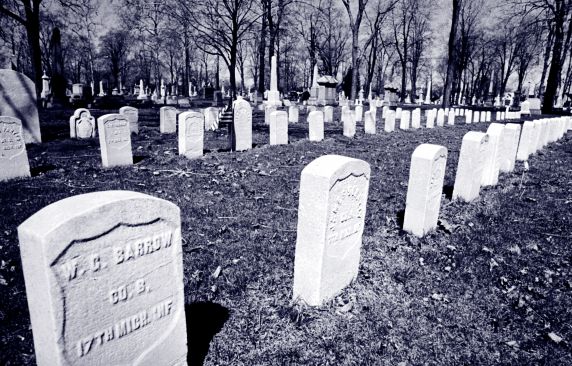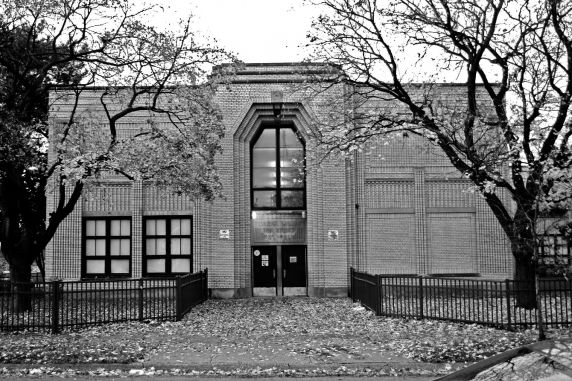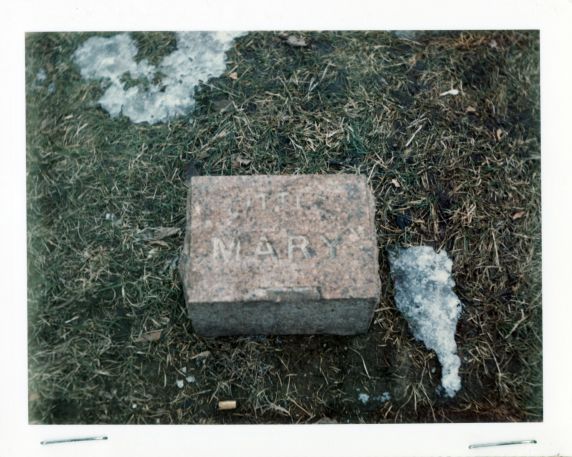Folklore Friday: Halloween Edition, v.3
This is the time of year that we love to indulge in sharing spooky tales with one another. In Southeastern Michigan, there is no lack of supposedly haunted places–many of which make an appearance in the Folklore Archive. The following three stories of haunted places evolved throughout the last 100 years and were recorded and analyzed by students in their field reports.
The Ghost of Knock-Knock Street
A fine place to start is with one of Detroit’s most enduring local ghost stories: Knock-Knock Street or the Ghost of Strasburg. Like many ghost stories it begins with an tragedy, in this case a traffic accident that resulted in the death of a child on Detroit’s East Side. The story shifts according to who is telling it, however, the central concept is that back in the 1950s there was a tragic hit and run accident on Strasburg Street. A little girl was struck by a vehicle and dragged some way. She tried to get the driver’s attention by knocking on the fender, to no avail,
and later died of her injuries. Since the 1950s, travelers on Strasburg Street have reported hearing a knocking from the fender or bottom of their car, supposedly the child trying to get their attention. At one point, the legend became so popular that police had to shut off access to the street because of heavy traffic by thrill seekers.
The topic is a popular one within the Folklore Archive. One of the more exhaustive inquiries into the legend can be found in Raymond Kettel’s 1979 paper The Legend of Knock Knock Street” [1980 (115)]. In it, Kettel interviews eight people who lived in the Strasburg neighborhood or experienced the knocking phenomena. The legend also appears in Dave Spybrook’s 1969 paper Ghostlore from Detroit [1969 (200)]. The latter shares a similar version of the story, but rather than Strasburg Street, the location of the accident and haunting is changed to Jefferson Avenue.
The Ghost of Denton Road
Mysterious lights are par for the course when we think of ghostly sightings. In the suburb of Canton, Denton Road has long been a destination for seekers of the supernatural. Glowing orbs of light, a “blue lady,” and the ghostly wail of a lost baby have been reported for generations. The origin story of these activities tells of a husband, who when confronted with his wife’s unfaithfulness, turned murderous. One night, upon finding the lovers together he flew into a rage, stabbed the man, then chased his wife out into the night. He caught up with her on the Denton Road Bridge and murdered her as she struggled to protect her baby, which she still held in her arms. The baby was never found. The floating lights seen are supposedly the spirits of the two victims, and occasionally, the wife manifests as a “blue lady” holding a lantern, looking for her missing child.
The legend is examined in Carolyn Channing’s 1979 paper, “The Legend of Denton Road. In it she interviews several young men who had visited the place and recorded their experiences of what they had seen, or not seen. The interviews are interesting in that they show how folklore changes according to the times, and how additional details add to the lore, including a story of dead bodies being dumped in the area, possible U.F.O. sightings, and the story of a troll that supposedly lives under the bridge. At the time that the stories were collected, the area was sparsely populated and Denton Road was a dirt road. The original wooden bridge was replaced in 2003 by the current concrete structure and the area is now heavily residential. Even so, the legend lives on today.
Little Mary
Most ghost stories evolve over time as they are passed from person to person. Jan Hayner’s Teenage Graveyard Ghost Stories [1970 (35)] is a fantastic example of watching the evolution of a story unfold as it travels through a community. The story examined is that of Little Mary, a child who reaches out, sometimes quite literally, from her grave seeking companionship from the people who visit her. The legend of Little Mary was likely based on the sad story of Mary McNaughton who was born in 1884 to a prominent family in Jackson, Michigan and died of peritonitis in 1892. It taps into the horrific experience of being buried alive, an occurrence more common prior to the beginning of the 20th century.
The paper begins with an interview with a friend who tells the story of Little Mary:
“This was supposed to have happened 20 years ago. She was only four years old and she had this disease—I forgot the name.Anyway, she had an attack and it looked like she was dead so they buried her. Only she wasn’t dead. For weeks after her mother had dreams that Mary wasn’t dead but no one believed her. Finally, to satisfy her they dug up the body. Her fingers were worn down from scratching on the coffin trying to get out. Now all the kids go out there and at certain times she will speak to you. You are supposed to bring little gifts and she will talk to you.”
The paper continues to collect different variations of the story from a range of people. The informants are identified by their relationship, rather than name, for privacy.
A Friend: “She was three years old when she died. She got catalepsy—sort of like sleeping sickness. They buried her and her mother kept having these dreams that Mary was moving around in her casket. Now if you go up to her grave and talk to her she’ll talk back or else she’ll give you a little present or something. And usually it is a flower from her grave—just one flower.” Note: the friend recounted the story as he drove the author around the cemetery at 1:30 in the morning.
The 15-year old sister of a friend:“All I know is that you are supposed to dance on her grave at midnight and light a candle and she will talk to you.”
The 16-year old daughter of a local librarian: “If you are there (at the grave) you can hear her crying and will see a hand glowing.”
A local salesman: “A cemetery attendant (in the 1800s) heard her scratching and finally opened the grave...now, she comes out of her grave and touches someone who is there at midnight.”
An older relative: “Little Mary was a 14-year old girl who was buried alive—she had sleeping sickness and looked dead—during the Civil War. Her doctor knew about her sickness but had been out of town. When he got back the next day they dig her up but she was already dead. And her hair was completely white.”
Friend of a friend: "There was this girl not too long ago who had to go through initiation for a college sorority. They told her to go to Mary’s grave at night and drive a wooden stake in the grave. The girl never returned and they found her body by the grave and her hair had gone white.”
And the quintessential source for urban lore, a friend of a sister of a friend: “On Saturday night at midnight when there is a full moon you will hear a baby cry and a lady will scream. If you kick her gravestone, the next day you will have a mark on your leg. If you stand on her grave, turn around three times and look at the big cross you will see her ghost. On a Wednesday night, if you say “I believe in little Mary” 38 times and look in a mirror and you will see her face. I tried it and it didn’t work!”
Through these informants, Channing was able to connect with people who had experienced supernatural occurrences at the gravesite.
Friend of a friend: "The first time I was there I saw what looked like a ghost. The second time—it was winter. There was snow on the grave, so I brushed it away with my foot and when I did I heard a baby crying....One night a bunch of us were out there and this buddy of mine and I were walking down this road out there and we saw a cloud of smoke coming at us. We ran back to the others and they said that “you guys are crazy.” One guy laughed and kicked the gravestone with his foot and on the way home he felt something bite his leg—the one he kicked the stone with—it was bleeding.”
Friend of friends: Two of the informants cited above told of a friend was overcome by the “spirit of Mary” and had a mysterious “gift” given to him, an experience that was verified by the victim: “I was at Pizza Hut one night and I got this strange feeling that I had to go see Little Mary. So I told the other guys I was with 'I gotta go out there'. She wants to give me something. So we went out there and there was a flower on her grave. So I picked it. Well, when I got back to the car I could not move my hand at all. So we had to throw the flower out the window and then I could move it again.”
All of the informants who had personal experiences refused to ever go to the grave again. Interested in more cemetery lore? There are more field reports in the Folklore Archive to explore, including:
• Hagle’s Urban Cemetery Lore [1966-6-16 (50]
• Snyder’s Cemetery Lore [1970 (61)]
• Goddard’s Legends and Memorats Collected from Junior High School Students 1977 (1)
We hope you have a Happy Halloween!
Folklore Fridays is an exploration of a theme or topic found within the Folklore Archive through text, audio, or still imagery. It generally appears on the Reuther Library blog on the last Friday of each month. The Folklore Archive, established in 1939, contains the oldest and largest record of urban folk traditions in the United States.
Elizabeth Clemens is an Audiovisual Archivist at the Walter P. Reuther Library.
*Photo of Von Steuben School is courtesy of the Michigan State Historic Preservation Office.




 Reddit
Reddit Facebook
Facebook LinkedIn
LinkedIn